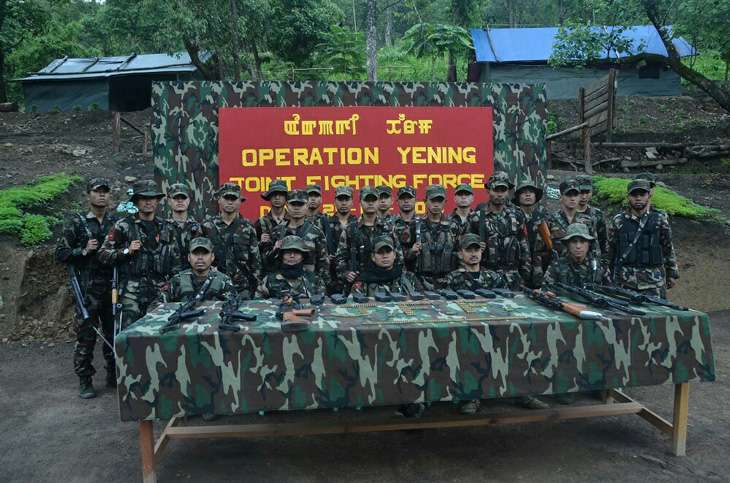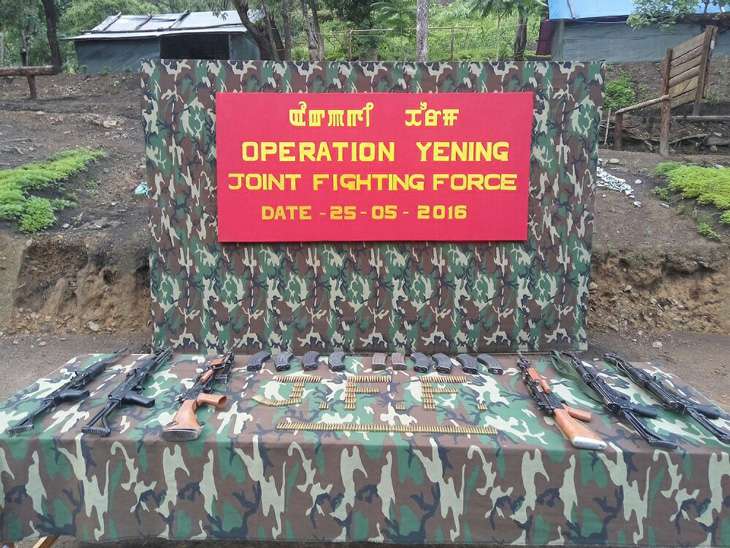A 40-day operation gone right: army & NIA thwart Naga rebels' plans

- A group of rebels belonging to the banned NSCN(K) crossed over from Myanmar to Nagaland on 8 March
- Their plan was to ambush armed forces personnel in Nagaland
- The NIA, army and Assam Rifles worked in close coordination to thwart the plan
- Eventually, after 40 days on the run, the rebels were forced to abandon their plan
- Was there a link between this plan and the 23 May attack in Manipur that killed six Assam Rifles soldiers?
- Myanmar\'s official diplomatic stance on this matter
On 23 May, an attack by separatist rebels in Manipur resulted in the death of a junior commissioned officer and five personnel of the Assam Rifles.
But just weeks before this latest attack, another deadly ambush was averted. The exhilarating cat-and-mouse game between the security forces and a heavily-armed group of rebels from Myanmar ended after 40 days in the hills of Nagaland. In the end, the militants scurried for cover, and were unable to carry out the plan of an ambush similar to the incident last year in Manipur.
Also read: Naga deal decoded: this could end India's longest insurgency
The latest ambush in Manipur might well have been the fallout of the earlier incident, since the militants were desperate to register some success against the army and security forces. While Naga militants were engaged in the first incident, rebels from Manipur were involved in the latest ambush, as a press release issued after the attack suggested.
Details of the operation
According to sources in the army headquarters, a group of over 20 heavily-armed militants belonging to the banned Khaplang faction of National Socialist Council of Nagaland (NSCN-K) crossed over to Kiphire in Nagaland from the neighbouring country early morning on 8 March.
They were led by Major Kughaito Sema, Major Akaho and Captain Nasaka, who were handpicked for the job by Brigadier Niki Sumi, the deputy commander-in-chief of the Naga outfit.
Alarm bells started ringing when the first signals from a cellphone used by Sema from somewhere near the border in Kiphire reached the agencies in the Ministry of Home Affairs (MHA).
The "ground sources" were activated immediately, and there was no dearth of intelligence pouring in about the movement of the group.
Also read: Jungle diary: Naga rebels celebrate their 'last Independence Day'
Subsequently, the National Investigation Agency (NIA) alerted the army and Assam Rifles, and within hours, a meeting was held by senior officers in Zunheboto to chalk out a plan of action to checkmate the rebels.

"As many as 400 personnel were engaged in the operation led by senior officers from 5 Assam Rifles and 12 Paras. There was constant sharing of information between all the agencies and units involved in the exercise. For the rebels, on the other hand, the task was daunting as they had to infiltrate, execute the lethal plan and sneak out after dodging the layers of security," an officer based in New Delhi explained.
After camping for two days at Seyochang, the militants decided to proceed to Achikuchu in the neighbouring Zunheboto distirct on 13 March.
However, the task of the security forces was rendered easier by the rebels themselves. According to a rebel functionary in Nagaland, the group suffered a setback when another 10-member team from Myanmar that was supposed to have joined the larger group in Nagaland became traceless.
He added that there was also a dispute over sharing the money sanctioned by the NSCN(K) headquarters for the mission.

The senior leaders supposedly garnered the lion's share of Rs 50,000, with a paltry amount left for the lower cadres.
The functionary explained that members of the group went on a feasting spree at Achikuchu, compelling some elders to inform the security agencies.
After being alerted by the NIA, the army and Assam Rifles surrounded the rebels in the village, but they slipped away just in time to avoid a confrontation through a route in the hills unknown to the army.
The squad remained incognito for a few days until it surfaced again at Agunato, where the rebels decided to draw a plan for the ambush near Zunheboto town.
The functionary revealed that a decision was taken to send a two-member group for a recce of a suitable spot.
But luck soon ran out for the group before the plan could be put into action. With the army and Assam Rifles trailing them, the entire group was compelled to move to another far-off village called Lizunaghuto.
Also read: The govt may clinch a Naga deal. But are all Nagas with it?
With the odds stacked against them, the senior leaders finally decided to withdraw and call off the operation sometime in the third week of April.
Information received by security agencies suggests that the squad had crossed the border to Myanmar on 18 April.
'Perfect coordination'
An official in the MHA attributed the success of the operation to "perfect coordination" among the National Investigation Agency (NIA) and the army, and the "accurate" inputs received from the ground sources on the movement of the rebels. He explained that there was not a single case of harassment to civilians during the entire five weeks the operation was on.
Sources in another militant outfit revealed that the decision for the operation was firmed up by the top brass of NSCN(K) at Taga (in Myanmar) early in February. Subsequently, commander-in-chief Khumchok Pangmei instructed his deputy Brigadier Niki Sumi to chalk out the details and select the group.

"The group was not sure of the spot where to lay the ambush. The conduct of the men was also highly questionable, and they had generated all the ingredients that contributed to failure," said a middle-rung cadre of a group in Manipur.
The episode is a grim reminder of the continuing campaign of violence by separatist outfits in Myanmar's Sagaing Division. Naypyidaw continues to deny the presence of the rebels on its soil, in spite of repeated reminders from New Delhi.
However, the quick receipt of information on the movement of the group by the agencies also reveals that NSCN(K)'s support base could be eroding fast in Nagaland.
In the last seven years, many senior functionaries such as Khole Konyak, Wangtin Naga and N Kitovi Zhimoni had decided to come overground and explore the possibility of a negotiated settlement with the government.
Edited by Shreyas Sharma
Also read: Emerging contours of the Naga settlement
First published: 31 May 2016, 8:32 IST




![BJP's Kapil Mishra recreates Shankar Mahadevan’s ‘Breathless’ song to highlight Delhi pollution [WATCH] BJP's Kapil Mishra recreates Shankar Mahadevan’s ‘Breathless’ song to highlight Delhi pollution [WATCH]](https://images.catchnews.com/upload/2022/11/03/kapil-mishra_240884_300x172.png)

![Anupam Kher shares pictures of his toned body on 67th birthday [MUST SEE] Anupam Kher shares pictures of his toned body on 67th birthday [MUST SEE]](https://images.catchnews.com/upload/2022/03/07/Anupam_kher_231145_300x172.jpg)






